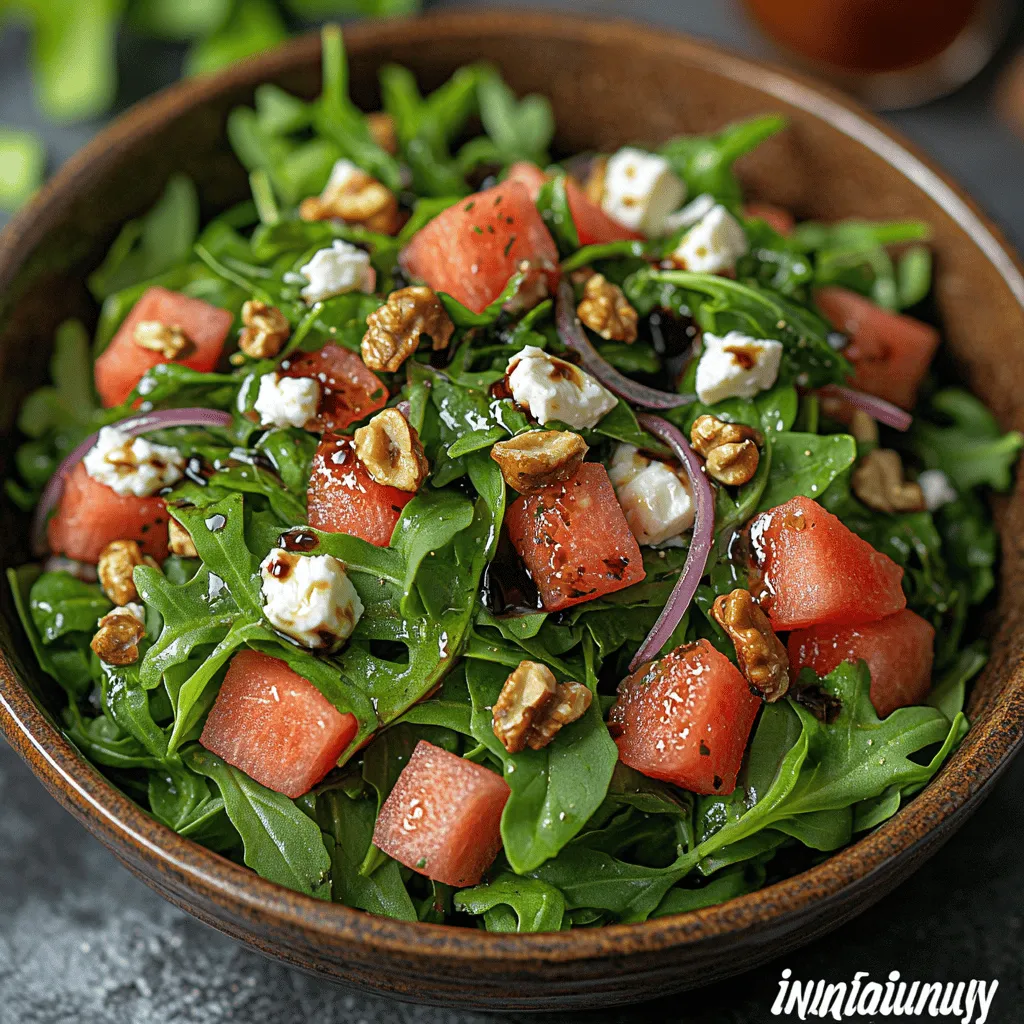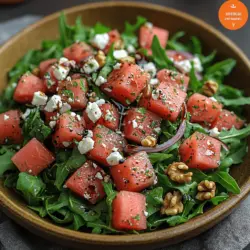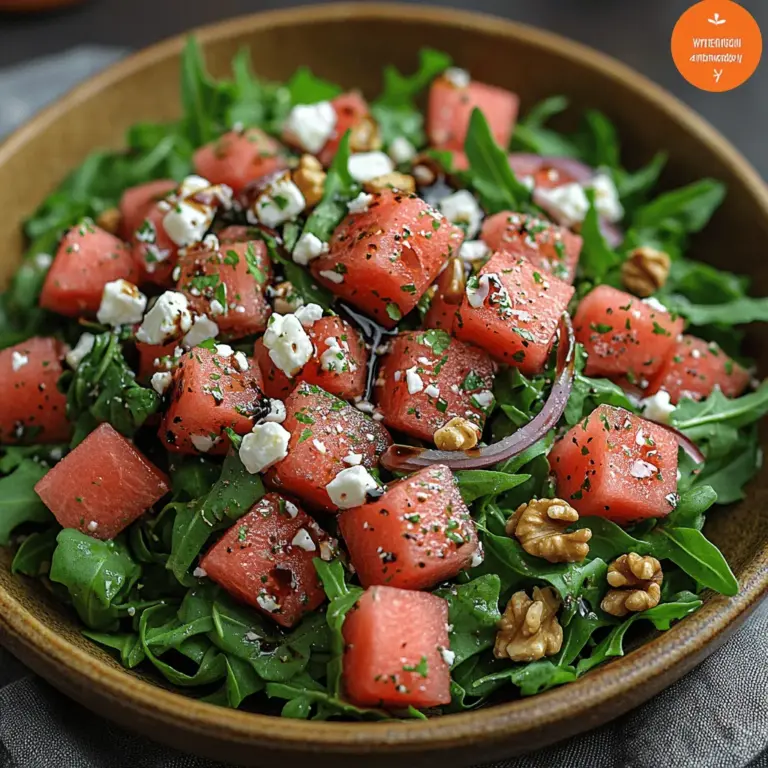Introduction
As the temperatures rise during the summer months, our cravings often shift towards lighter, fresher meals that invigorate both the body and spirit. Fresh salads have become increasingly popular, serving not just as a side dish but as a vibrant centerpiece for summer dining. Among the plethora of salad options available, the refreshing watermelon arugula salad stands out as a particularly delightful choice. This salad combines the juicy sweetness of watermelon with the peppery bite of arugula, creating a harmonious balance of flavors that is both satisfying and nourishing.
In addition to its tantalizing taste and beautiful presentation, the watermelon arugula salad boasts an impressive array of health benefits. This dish is packed with nutrient-dense ingredients that contribute to overall wellness. The key components include fresh arugula, hydrating watermelon, tangy feta cheese, crunchy walnuts, and a drizzle of balsamic glaze and olive oil. Each of these ingredients not only enhances the flavor profile of the salad but also provides essential nutrients that support a healthy lifestyle.
Let’s delve deeper into the nutritional benefits of these key ingredients to understand why this salad is not just a feast for the senses but a smart choice for summer eating.
The Nutritional Benefits of Key Ingredients
Arugula
Arugula, often referred to as rocket, is a leafy green that is characterized by its distinct peppery taste. This salad green is not only a favorite among chefs for its bold flavor, but it also offers a plethora of nutritional benefits. Arugula is low in calories and high in essential vitamins and minerals, making it an excellent choice for those looking to maintain a healthy diet without sacrificing taste.
One cup of arugula contains significant amounts of vitamins A, C, and K, along with folate and calcium. Vitamin A is crucial for maintaining healthy vision, skin, and immune function, while vitamin C acts as a powerful antioxidant that helps protect the body from free radical damage. Vitamin K plays an essential role in blood clotting and bone health, highlighting the importance of including arugula in your meals.
Moreover, arugula is rich in antioxidants, which can help reduce inflammation in the body and lower the risk of chronic diseases. Its unique flavor and nutrient profile make it an ideal base for salads, providing a sharp contrast to sweeter ingredients like watermelon.
Watermelon
Watermelon is the quintessential summer fruit, known for its refreshing juiciness and vibrant pink hue. Not only is watermelon delicious, but it also packs a nutritional punch. This fruit is composed of over 90% water, making it an excellent choice for hydration during hot summer days.
In terms of vitamins, watermelon is rich in vitamins A and C. Vitamin A supports healthy skin and vision, while vitamin C boosts the immune system and promotes skin health. Additionally, watermelon contains lycopene, an antioxidant that has been linked to various health benefits, including reduced risk of certain cancers and heart disease.
Seasonal availability is another reason to enjoy watermelon during the summer. Freshly harvested watermelon is at its peak flavor and nutritional content, making it a perfect addition to salads, smoothies, and other light dishes. Incorporating watermelon into your meals not only enhances flavor but also contributes to your hydration and nutrient intake.
Feta Cheese
Feta cheese is a tangy, crumbly cheese that is often used in Mediterranean cuisine. Its distinct flavor profile adds a creamy richness to salads, making it a beloved ingredient among salad enthusiasts. Beyond its delightful taste, feta cheese also offers several nutritional benefits.
Feta is lower in fat and calories compared to many other cheeses, making it a healthier option for adding creaminess to dishes. It is a good source of protein, which is essential for muscle repair and overall body function. Moreover, feta cheese contains calcium, an important mineral for maintaining strong bones and teeth.
Incorporating cheese into salads not only enhances flavor but also provides a satisfying texture and nutritional balance. The combination of feta with the sweet watermelon and peppery arugula creates a complex flavor experience that is both refreshing and indulgent.
Walnuts
Walnuts are often regarded as a superfood due to their impressive nutritional profile. These nuts are packed with healthy fats, particularly omega-3 fatty acids, which are essential for heart health. Consuming walnuts can help lower bad cholesterol levels and reduce inflammation in the body.
In addition to healthy fats, walnuts are a source of protein and fiber, making them a great addition to salads for added crunch and substance. They also contain vitamins and minerals such as magnesium, phosphorus, and vitamin B6, each playing a role in various bodily functions, including energy metabolism and bone health.
Including nuts like walnuts in your diet not only contributes to heart health but also promotes satiety, helping to keep you feeling full and satisfied. In the watermelon arugula salad, walnuts provide a delightful crunch that contrasts beautifully with the soft texture of the watermelon and feta cheese.
Balsamic Glaze and Olive Oil
No salad is complete without a flavorful dressing, and in the case of the watermelon arugula salad, a simple yet delicious dressing of balsamic glaze and extra-virgin olive oil elevates the dish to new heights. Dressings play a crucial role in salads, enhancing flavors and adding richness to the overall experience.
Balsamic glaze, a reduction of balsamic vinegar, offers a sweet and tangy flavor that complements the sweetness of the watermelon and the pepperiness of the arugula. It adds depth to the salad, making each bite a delightful experience.
Extra-virgin olive oil is another key component of the dressing, known for its heart-healthy monounsaturated fats. Rich in antioxidants and anti-inflammatory properties, olive oil not only enhances the flavor of the salad but also provides numerous health benefits. It supports cardiovascular health, improves digestion, and may even contribute to weight management.
Together, balsamic glaze and olive oil create a balanced dressing that perfectly ties together the flavors of the watermelon, arugula, feta, and walnuts, resulting in a refreshing salad that is as nutritious as it is delicious.
—
With this understanding of the key ingredients and their health benefits, we can move into the preparation stage of our refreshing watermelon arugula salad. This vibrant dish is not only easy to make but also a fantastic way to enjoy the flavors of summer while nourishing your body with essential nutrients. Stay tuned for the next section, where we will explore the step-by-step instructions for creating this delightful salad.

Step-by-Step Guide to Making Watermelon Arugula Salad
Creating a refreshing watermelon arugula salad is not just about tossing ingredients together; it’s about crafting a dish that balances flavors, textures, and colors. Here’s a detailed guide to help you prepare this delightful salad with ease.
Preparation of Ingredients
Washing and Drying Arugula for Optimal Freshness
Begin by selecting fresh arugula. Look for vibrant green leaves that are crisp and free from any yellowing or wilting. To wash the arugula, fill a large bowl with cold water and gently submerge the leaves. Swirl them around to dislodge any dirt or grit. After a few minutes, lift the arugula out of the water and place it in a colander to drain.
Once drained, it’s essential to dry the leaves thoroughly to prevent excess moisture from diluting the salad dressing. You can use a salad spinner for efficiency, or alternatively, pat the leaves dry with a clean kitchen towel. This step ensures that your arugula remains fresh and crisp when served.
Selecting the Best Watermelon and Cutting It into Perfect Cubes
Choosing the right watermelon is crucial for the success of your salad. Look for a watermelon that feels heavy for its size and has a uniform shape. The skin should be firm and free from dents or soft spots. A ripe watermelon will have a creamy yellow spot on one side, indicating it was left to ripen in the sun.
To cut the watermelon, first, slice off both ends to create a stable base. Stand the watermelon upright and carefully cut down the sides to remove the rind. Once the rind is removed, slice the watermelon into quarters, then cut each quarter into cubes. Aim for bite-sized pieces, approximately 1-inch in size, to ensure easy eating and even distribution within the salad.
Assembling the Salad
Layering Ingredients for Visual Appeal and Flavor Balance
The way you assemble your salad can significantly affect both its aesthetic and taste. Start with a generous base of arugula, allowing the leaves to form a bed for the other ingredients. Next, add the watermelon cubes, ensuring they are evenly distributed. The vibrant pink of the watermelon against the green arugula creates a visually stunning contrast.
For additional texture and flavor, sprinkle the sliced cucumber and red onion on top. The cucumber adds a refreshing crunch, while the onion provides a mild sharpness that elevates the salad.
Gentle Tossing to Maintain Ingredient Integrity
Once all the ingredients are layered, it’s time to toss the salad. It’s important to do this gently to avoid bruising the delicate arugula and watermelon. Use two large utensils – a pair of salad tongs or wooden spoons – and lightly lift the ingredients from the bottom, letting them fall back down together. This technique ensures that every bite offers a perfect combination of flavors and textures without turning the salad into a mushy mess.
Incorporating Feta and Dressing
Adding Feta Without Crumbling It Excessively
Feta cheese is a wonderful addition to watermelon arugula salad, providing a creamy and salty contrast to the fresh ingredients. To incorporate feta, use your fingers to crumble it into small chunks. Aim for larger pieces to avoid excessive crumbling, which can create a dry, powdery texture. Disperse the feta evenly over the top of the salad before adding the dressing, allowing its flavor to meld with the other ingredients without overwhelming them.
Whisking Together the Dressing for Best Flavor Integration
For the dressing, whisk together extra virgin olive oil, balsamic vinegar, honey, and a pinch of salt and pepper in a small bowl. The ratio of oil to vinegar should be approximately three parts oil to one part vinegar for a balanced flavor. If you prefer a creamier dressing, consider adding a dollop of Greek yogurt or a splash of lemon juice for brightness. Whisk until the mixture is well blended and creamy. Taste and adjust seasoning as necessary, adding more honey for sweetness or vinegar for tang, based on your preference.
Seasoning and Garnishing
Enhancing Flavors Without Overpowering
To season the salad, sprinkle a little sea salt and freshly cracked black pepper over the top. This simple step enhances the flavors of the ingredients without overshadowing their natural taste. The salt draws out the sweetness of the watermelon and the pepper adds a subtle kick, creating a harmonious balance.
The Role of Mint as a Garnish and Its Flavor Profile
Fresh mint is an excellent garnish that brightens the salad and adds an aromatic quality. Chop a handful of mint leaves finely and sprinkle them over the assembled salad just before serving. Mint complements the sweetness of the watermelon and the peppery notes of arugula, bringing a refreshing complexity to the dish.
Serving Suggestions and Pairings
The watermelon arugula salad is incredibly versatile and can be enjoyed in various ways. It makes a fantastic standalone meal, especially during the hot summer months. Alternatively, it works beautifully as a side dish alongside grilled meats, seafood, or even as part of a buffet spread.
Complementary Dishes That Pair Well
For those looking for pairing ideas, consider serving this salad with grilled chicken or shrimp. The lightness of the salad contrasts well with the smoky flavors of grilled proteins. Additionally, it pairs nicely with simple dishes like roasted vegetables or quinoa pilaf, providing a refreshing counterpoint to heartier fare.
Suggestions for Beverages
To enhance your meal experience, consider beverages that complement the fresh flavors of the salad. A crisp white wine, such as Sauvignon Blanc or a light rosé, pairs excellently. If you prefer non-alcoholic options, a sparkling water with a splash of lime or a refreshing iced tea with mint can elevate the dining experience.
Conclusion
The watermelon arugula salad is a perfect embodiment of summer’s bounty, combining the sweetness of watermelon with the peppery bite of arugula and the creamy tang of feta. This salad not only offers a refreshing taste but also boasts numerous health benefits. Watermelon is hydrating and low in calories, while arugula is packed with vitamins and minerals.
As you prepare this vibrant dish, remember that using fresh, quality ingredients is key to achieving the best flavor and nutrition. Enjoy this seasonal delight as part of a healthy lifestyle, and don’t hesitate to experiment with different ingredients to make it your own. Whether served at a summer barbecue, a picnic, or as a light lunch, the watermelon arugula salad is sure to impress and satisfy.


